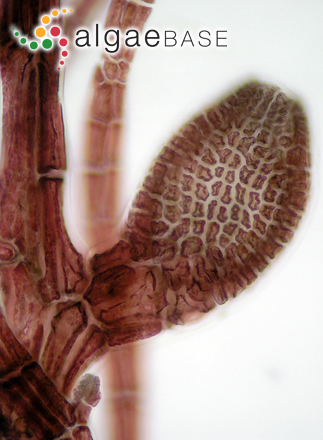Polysiphonia elongata (Hudson) Sprengel 1827

Current name:
Carradoriella elongata (Hudson) Savoie & G.W.Saunders
Ría de Vigo, Galicia, Spain, 2016Ignacio Bárbara (barbara@udc.es)
Publication Details
Polysiphonia elongata (Hudson) Sprengel 1827: 349
Published in: Sprengel, K.[P.J.] (1827). Systema vegetabilium Editio decima sexta. Voluminis IV. Pars I. Classis 24. Vol. 4 pp. [i]-iv, [1]-592. Gottingae [Göttingen]: sumtibus Librariae Dieterichianae.
Type Species
The type species (holotype) of the genus Polysiphonia is Polysiphonia urceolata (Lightfoot ex Dillwyn) Greville.
Status of Name
This name is currently regarded as a synonym of Carradoriella elongata (Hudson) Savoie & G.W.Saunders.
Source of Synonymy
Savoie, A.M. & Saunders, G.W. (2018 '2019'). A molecular assessment of species diversity and generic boundaries in the red algal tribes Polysiphonieae and Streblocladieae (Rhodomelaceae, Rhodophyta) in Canada. European Journal of Phycology 54(1): 1-25.
Basionym
Conferva elongata Hudson
Type Information
Type locality: "Habitat in littoribus marinis frequens." [England]; (Hudson 1762: 484) Lectotype: BM-K; (Maggs & Hommersand 1993: 327)
Origin of Species Name
Adjective (Latin), elongated (Stearn 1983).
General Environment
This is a marine species.
Description
Cartilaginous, cylindrical, dark reddish brown fronds, to 300 mm long, with crimson ramuli, from discoid base. Branches alternate to pseudodichotomous, densely clothed in spring with gelatinous, ephemeral ramuli, tapered at base and apex. Small cental siphon with 4 large primary pericentral siphons, 4 alternating secondary pericentral siphons, and in older parts 8 tertiary pericentral siphons and a zone of corticating cells. Articulations barely visible in corticated parts, rather broader than long near base, to longer than broad in ramuli.
Habitat
On stones and shells, open sandy and gravelly substrates, intertidal to deepish subtidal, widely distributed, common, sometimes washed ashore in quantity.
Created: 31 March 1996 by M.D. Guiry.
Last updated: 16 November 2023
Verification of Data
Users are responsible for verifying the accuracy of information before use, as noted on the website Content page.
Linking to this page: https://www.algaebase.org/search/species/detail/?species_id=173
Citing AlgaeBase
Cite this record as:
M.D. Guiry in Guiry, M.D. & Guiry, G.M. 16 November 2023. AlgaeBase. World-wide electronic publication, National University of Ireland, Galway. https://www.algaebase.org; searched on 22 November 2024
 Request PDF
Request PDF














